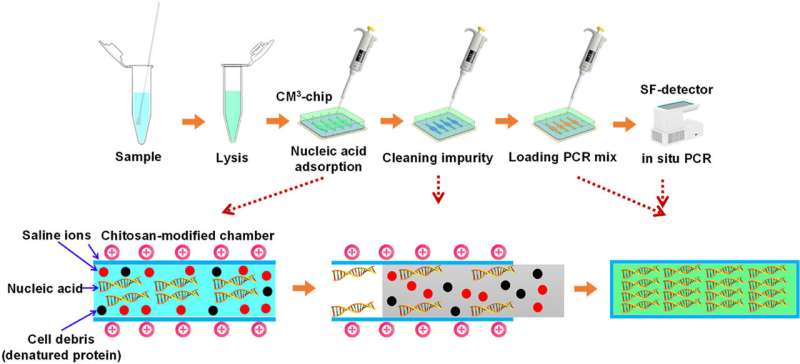This article has been reviewed according to Science X's editorial process and policies. Editors have highlighted the following attributes while ensuring the content's credibility:
fact-checked
peer-reviewed publication
trusted source
proofread
Microfluidic real-time detection equipment developed for pathogen nucleic acid

The biomedical optics research team in Anhui Institute of Optics and Fine Mechanics, Hefei Institutes of Physical Science of the Chinese Academy of Sciences (CAS), has developed a device for on-site immediate detection of pathogen nucleic acid. Their research results were published in Analytica Chimica Acta.
Microfluidic chips have been widely used in the nucleic acid detection of pathogens. The chips often use magnetic beads or silica gel films with high specific surface area to adsorb nucleic acid, but it may also lead to more residual fluid release agents and impurities. Therefore, microfluidic chips usually need to integrate multiple reagent storage tubes and perform fluid control in combination with microvalves and micropumps, to realize nucleic acid extraction and impurity cleaning. The complicated structure increases the complexity of the preparation process and supporting detection equipment of microfluidic chips.
In this study, the researchers developed the mobile kit (Mkit) consisting of a chitosan-modified minimalistic microfluidic chip (CM3-chip) and smartphone, which realized the point-of-care testing of the nucleic acid of pathogens.
The lumen wall of CM3-chip was modified with chitosan. Under acidic pH conditions, the primary amine in chitosan (pKa = 6.2 to 7.0) was positively charged. The Hofmeister effect showed that protonated amines were more likely to bond to negatively charged nucleic acids than other ions through the electrostatic interactions. CM3-chip could be directly amplified in situ after the enrichment of nucleic acid. Smartphones were used to control the whole process of detection, including temperature control, image acquisition, data processing and result analysis.
Mkit has many advantages over traditional methods, including no centrifugation, no complex cleaning, no magnet attachment, and high sensitivity.
A series of biological experiments showed that the detection equipment is universally applicable, selective, and user-friendly, and it can identify respiratory infectious agents with similar clinical symptoms. Artificially prepared saliva samples of H5N6 and IAV infections were also detected by Mkit.
More information: Ke Yang et al, Mkit: A mobile nucleic acid assay based on a chitosan-modified minimalistic microfluidic chip (CM3-chip) and smartphone, Analytica Chimica Acta (2023). DOI: 10.1016/j.aca.2023.341030
Journal information: Analytica Chimica Acta
Provided by Chinese Academy of Sciences




















